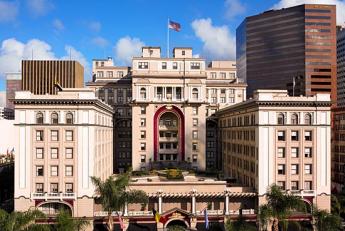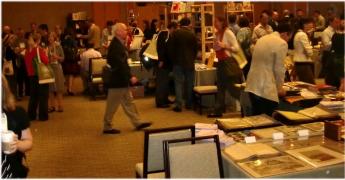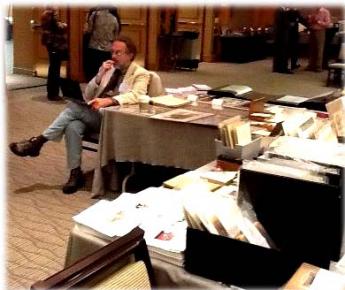Antiquarian Booksellers' Association of America Ten Pound Island Book Company
Librarians as Humans

By Greg Gibson
Tuesday, June 18. “F Street.” - I’m in San Diego for a gathering of more than three hundred Rare Book and Manuscript Librarians. I’ve brought rare pamphlets, broadsides, and a few books and manuscripts, in a suitcase, to spread out like peacock feathers at the “Dealers Showcase” event tomorrow. But as I walk the streets on this fine afternoon, I am distracted, confused.
From 1968 to 1970 I worked as a shipfitter on a Navy sub tender anchored out at Point Loma. I got to know the town intimately during that time, having walked it for the better part of three years, as only a sailor on liberty can walk a place. But the city has changed so much since then that I can’t get my bearings. It has turned into some kind of corporate Disneyland.
I walk, and walk, and finally recognize the US Grant Hotel - in whose bar, in 1968, a likely looking sailor rarely loitered for more than half an hour without being propositioned. Now it’s all snazzed up opposite a glitzy neon mall where, thirty-five years before, crazed evangelists preached doom from soap boxes and drug dealers scuttled like centipedes.
I walk on, in search of my old hangouts… The Swank, Singapore, Hustlers – all gone. China Doll, my favorite, on 5th St., is now a Hard Rock Café, with a historical plaque on the outside wall, recalling the glories of 1906 but omitting the lively scuzz of 1966.
Best of all was the Hollywood Theater on F street, where I fell in love with a stripper whose name was “The Loveliness of Chris.” She was the comedian’s daughter. You can’t make this stuff up.
By late Tuesday afternoon I have walked my way back to the present, just in time to spread my feathers.
Wednesday June 19. “Dealer’s Showcase” - Colleague Lorne Bair best describes the logistics of this event, lauding “the fantastic idea of moving the showcase to Wednesday and putting the coffee breaks in the same room with us… the room practically overflowing with librarians several times in the course of the day.”
Forty of the best book dealers in the country, with Special Collections people coming in and out like the tides, and a whole day to ponder the eternal question, “What do Librarians Want?”
At least, that’s the way I used to see it. Mysterious. Daunting. Forbidding.
I confess. In the past I have been guilty of objectifying librarians - male and female - as invoice depositories, check writing machines, minders of holes in card catalogs.
However, after five years of these conferences, brilliantly co-engineered by the ABAA and RBMS, I see things differently.
The “takeaway” is listening to someone like George Miles of the Beinecke talk about the things that interest him these days – What does a library do when they own everything? They set an intelligent man on the hunt for material beyond “everything.” Or Peter Hanff of the Bancroft talking about tattoos. Who knew? Deborah Whiteman at Santa Clara, or Jay Satterfield at Dartmouth, providing rare books and manuscripts to make period studies come alive for students. Pirates and shipwrecks. Medicine in colonial New England.
I have come to realize that these people are not “Librarians.” They’re smart, enthusiastic, creative men and women, who get as much of a kick out of what they’re doing as we booksellers get from what we do. And with budget cuts, staff reductions, and monstrously increased workloads leaving them less time to pour over quotes and catalogs, our responsibilities as dealers change. Our abilities to locate material and to place it within its historical context can be of great benefit in collection development, especially if we know who we’re working with, and what they’re working on.
Terry Belanger, who almost always puts things best, put it best.
“Librarians don’t buy books from catalogs, and they don’t buy them off the Internet. Librarians buy books from people.”
This is going to be fun…
And finally, here's one I did not take to San Diego. It was too big to fit in my suitcase.
Print. (Hohmann, Johann). HISTORIA ANIMATUM MA(RINARUM). ABBILDLICHE GESCHICHRINORUM ICONOGRAPHICATE DER SEE-THIERE... BALAENARUM WALFISCHE.
(Nuremburg. circa 1760.) Hand colored engraving. Plate area 23 1/2 x 20 1/2 inches. A rare and marvellous whaling print, thoroughly described in Ingalls.
Basically, it is composed of four parts, mostly borrowed from Martens and Zorgdragger. The top panel is a “description of the whale fishery” taken from a 1675 engraving by Martens showing all phases of the Spitsbergen whale fishery, but keyed differently, with extensive marginal description. The center panel depicts six whales found in the Spitsbergen fishery, a whale louse, a sea bird, sea worms, and harpoons. The images are appropriated from another engraving by Martens, and from several engravings taken from Zorgdragger’s 1720 work on whaling. As Ingalls notes, “they have not been copied exactly, however, as the taxonomy is rather confused and incorrect.” The panel on the lower left depicting ships caught in the ice is from Martens. The tryworks scene in the lower right, possibly of Hamburg, is from neither Martens or Zorgdragger.”
Ingalls 447. Beautiful original color on lightly toned paper $3500
(Posted in Bookman’s Log. Presented here by permission of the author.)


